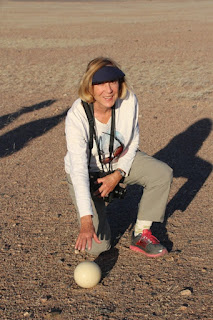We leave Windhoek, Namibia and fly south toward
Sosessuvlei to see the red sand dunes.
The landscape is desolate; metal roofs on scattered buildings glisten
like diamonds in the sun. Cars below are few and far between as a dirt road
snakes its way along the narrow paved two-lane road.
 |
| View out the window of our small transport plane. |
I marvel at jaw-dropping views of this spectacular
landscape. Eventually I notice the long, gravel landing strip which fades into the
vast emptiness as the plane's wheels touch down.
 |
| Getting to various camps requires transport via small plane. |
 |
| There is a simple beauty in the starkness of the desert. |
We land and
head in a safari vehicle for the private 90,000 acre Kulala Wilderness Reserve.
Massive gold-orange dunes, shaped by wind into this unbelievably beautiful
starkness, rise a thousand feet from the floor of the world’s oldest desert.
 |
| Stairs leading to our rooftop "hideaway." |
 |
| We scan the landscape from our rooftop perch. |
In the afternoon we set out to explore the Kulala
Wilderness Reserve. Everything living here has adapted to the harsh, dry
climate. Challenges include finding water, conserving energy (many are
nocturnal), and finding food (hunt early morning or late evening). Trees have
tiny leaves because of water scarcity or thorns as protection from grazing
animals.
 |
| Spring bok can go a year without water--desert adaptation. |
 |
| An ostrich egg left to nature. |
Our guide points out “fairy circles” and explains
that the origin of these rock formations on the ground is not really known. We
find an ostrich egg that had been laid in the open on bushman’s grass. Most
likely it will never hatch.
 |
| Our dining experiences were superb. |
After driving for awhile, we stop for snacks and
wine before heading back to camp and a sumptuous dinner.
Even better, we are
treated to native singing, dancing, clapping, and foot tapping by the energetic
staff. Their happy voices lift us all, till we forget what a long day it has
been—and the early morning wake-up call we will have in order to see sunrise on
the magnificent sand dunes of Sossusvlei.
 |
| Staff was very friendly, helpful, and accommodating--a real asset for remote camps. |
Photos by Larry and Beverly Burmeier








No comments:
Post a Comment